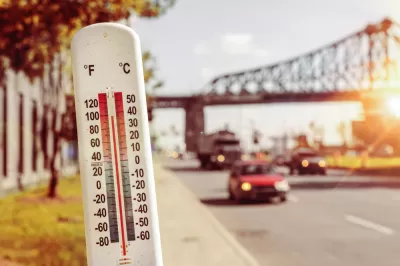The California Healthy Places Index: Extreme Heat Edition is a tool which provides datasets on projected heat exposure for California, including place-based indicators measuring community conditions and sensitive populations.

The Healthy Places Index (HPI), a resource developed by the Public Health Alliance of Southern California, is well-known as a powerful tool that can be used to explore community conditions that predict life expectancy, compare and rank scores at multiple California geographies, and learn about concrete and actionable policy solutions.
There is now the Extreme Heat Edition of the HPI which is developed by the Public Health Alliance in partnership with the UCLA Luskin Center for Innovation. This new tool provides datasets on projected heat exposure for California, including place-based indicators measuring community conditions and sensitive populations. It also provides a list of resources and funding opportunities that can be used to address extreme heat.
Specifically, the tool can be used to:
- Understand underlying heat vulnerability and resilience characteristics of a community
- Identify resources to mitigate adverse effects of extreme heat
- Prioritize public and private investments, resources and programs
To learn more about the methodology and capabilities of the HPI: Extreme Heat Edition, please review the technical report.
FULL STORY: New Online Mapping Tool Helps California Prepare for Extreme Heat

Alabama: Trump Terminates Settlements for Black Communities Harmed By Raw Sewage
Trump deemed the landmark civil rights agreement “illegal DEI and environmental justice policy.”

Planetizen Federal Action Tracker
A weekly monitor of how Trump’s orders and actions are impacting planners and planning in America.

The 120 Year Old Tiny Home Villages That Sheltered San Francisco’s Earthquake Refugees
More than a century ago, San Francisco mobilized to house thousands of residents displaced by the 1906 earthquake. Could their strategy offer a model for the present?

In Both Crashes and Crime, Public Transportation is Far Safer than Driving
Contrary to popular assumptions, public transportation has far lower crash and crime rates than automobile travel. For safer communities, improve and encourage transit travel.

Report: Zoning Reforms Should Complement Nashville’s Ambitious Transit Plan
Without reform, restrictive zoning codes will limit the impact of the city’s planned transit expansion and could exclude some of the residents who depend on transit the most.

Judge Orders Release of Frozen IRA, IIJA Funding
The decision is a victory for environmental groups who charged that freezing funds for critical infrastructure and disaster response programs caused “real and irreparable harm” to communities.
Urban Design for Planners 1: Software Tools
This six-course series explores essential urban design concepts using open source software and equips planners with the tools they need to participate fully in the urban design process.
Planning for Universal Design
Learn the tools for implementing Universal Design in planning regulations.
Clanton & Associates, Inc.
Jessamine County Fiscal Court
Institute for Housing and Urban Development Studies (IHS)
City of Grandview
Harvard GSD Executive Education
Toledo-Lucas County Plan Commissions
Salt Lake City
NYU Wagner Graduate School of Public Service





























